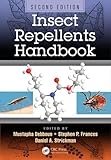Insect repellents handbook / edited by Mustapha Debboun, Stephen P. Frances, Daniel A. Strickman.
Material type: TextPublisher: Boca Raton : CRC Press, Taylor and Francis, 2015Edition: 2nd edDescription: 1 online resource (402 pages)Content type:
TextPublisher: Boca Raton : CRC Press, Taylor and Francis, 2015Edition: 2nd edDescription: 1 online resource (402 pages)Content type: - text
- computer
- online resource
- 9781466553583 (electronic bk.)
- 1466553588 (electronic bk.)
- 614.432
Description based upon print version of record.
Front Cover; My dear three brothers and four sisters; my beautiful and loving wife, Natalie, and our wonderful children: Ameena, Adam, and David; and to the memory of my beloved parents.; Contents; Preface; Acknowledgments; Contributors; Chapter 1: Terminology of Insect Repellents; Chapter 2: Neuromolecular Basis of Repellent Action; Chapter 3: How Repellents Work : Neurophysiological and Behavioral Analyses; Chapter 4: In Silico Models for Development of Insect Repellents; Chapter 5: Can Green Chemistry Provide Effective Repellents?; Chapter 6: Excitorepellency
Chapter 7: Evaluation of Repellent Efficacy in Reducing Disease IncidenceChapter 8: Testing Methods for Insect Repellents; Chapter 9: Plant-Based Insect Repellents; Chapter 10: Insect Repellents Derived from Australian Plants and Implications for Public Health Messages; Chapter 11: Topical Repellent Active Ingredients in Common Use; Chapter 12: Spatial or Area Repellents; Chapter 13: Marketing for Efficacy, Acceptability, Safety, and Health; Chapter 14: Klun and Debboun Modules: Uses and Data Analysis; Chapter 15: Use of Chemical Mixtures as Insecticides and Repellents
Chapter 16: Use of Repellents Formulated in Specialized Pheromone and Lure Application Technology for Effective Insect Pest ManagementChapter 17: Strategies for Using Personal Protection Products; Chapter 18: Best Practices for Use of Personal Protection Products; Chapter 19: Commercially Available Insect Repellents and Criteria for Their Use; Chapter 20: Alterations of Blood-Feeding Behavior and Repellent Response of Pathogen-Infected Biting Flies; Chapter 21: Insect Repellents for Other Potential Use; Chapter 22: Future of Insect Repellents; Appendix; Back Cover
This book provides an update of the first edition, which is recognized as the definitive reference on insect repellents. The Second Edition reflects the current state of insect repellent science. It covers the processes involved in the development and testing of new active ingredients and formulations, and discusses the practical uses of repellents. It is a resource that will be useful to a wide variety of professionals including insect repellent researchers, medical entomologists, public health and medical personnel, industry and sales professionals, government regulators, and wildlife scient.

There are no comments on this title.